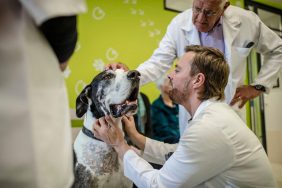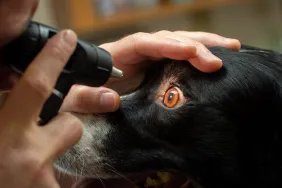This article is brought to you courtesy of the National Canine Cancer Foundation.
See more articles on canine cancer.
Donate to the Champ Fund and help cure canine cancer.
Description
Malignant lymphoma or lymphosarcoma is one of the most common neoplasms (tumor) in dogs. They usually originate in lymphoid tissues, like the lymph nodes, spleen, and bone marrow. However, they can arise in any tissues in the body. Lymphoma accounts for approximately 7-24% of all canine neoplasia (formation of a new tissue) and 83% of all canine hematopoietic (blood cells) malignancies. Lymphoma is generally seen in middle aged to older dogs (median age, 6-9 years). Breeds that are believed to have a higher incidence of lymphoma comprise Boxers, Bull Mastiffs, Basset Hounds, Saint Bernards, Scottish Terriers, Airedales and Bull dogs. Dogs with a lower risk include Dachshunds and Pomerians. Neutered females tend to have a better prognosis.
World Health Organization (WHO) has classified different stages of lymphoma based on its degree of metastasis and invasiveness. They are as follow:
* Stage I: Ailment restricted to a single lymph node.
* Stage II: Regional lymphadenopathy (restricted to one side of diaphragm).
* Stage III: Generalized lymphadenopathy (enlargement of lymph nodes)
* Stage IV: Enlargement of the liver and spleen or hepatosplenomegaly (with or without lymphadenopathy)
* Stage V: Bone marrow, CNS (Central Nervous System), or involvement of other extranodal sites
Generic causes
The etiology is largely unknown and likely multi factorial. Current investigations are going on to ascertain some definitive causes. Chromosomal aberrations (change in the normal structure of chromosomes) have been reported in canine lymphoma. Though the involvement of a retrovirus (any of a group of viruses, many of which cause tumor) in the pathogenesis (development of a diseased or morbid condition) of canine lymphoma has not been confirmed, certain viral particles with properties similar to retroviruses have been detected in the short-term cultures of canine lymphoma tissue. Certain environmental factors are also believed to trigger the disease. A hospital based case control study of dogs indicated that owners in households that developed malignancy sprayed 24-D herbicides in their lawns. Dogs living in industrial areas are believed to be at an increased risk of lymphoma. Moreover, households where owners use more chemicals like paints and solvents, dogs have been found to be slightly predisposed. Weak immune system has also been identified in dogs with lymphoma.
Types of lymphoma
There are basically 5 types of lymphoma like multi-centric, mediastinal, gastro-intestinal, cutaneous, extra nodal and central nervous system.
Multi centric lymphoma
Multicentric lymphoma mostly affects the external lymph nodes. They may or may not involve other organs. But in a vast majority of cases it has been observed that lymphoma eventually invades the organs and the healthy tissues are replaced by the diseased ones. Death occurs mostly due to organ failure as the organ becomes dysfunctional under the impact of the disease.
Symptoms
Multicentric lymphoma is the most common type of lymphoma found in dogs. It is characterized by painless swelling of the lymph nodes. Hepatosplenomegaly (enlargement of spleen and liver) and bone marrow involvement are common. Most of the dogs do not show any distinctive signs of illness. But symptoms like anorexia, weight loss, ascites (abnormal accumulation of fluid in the abdomen), dyspnea (difficulty in breathing), polydipsia (abnormal thirst), polyuria (excessive passage of urine), fever, anemia, hemorrhage, sepsis (inflammation of the whole body) might be palpable.
Diagnostics and Clinical Staging
For most dogs suspected of having lymphoma a thorough physical examination should entail a complete blood count with a differential cell count, a platelet count, serum biochemistry profile and urinanalysis. Finally, obtaining tissue or cytologic specimens for a definitive diagnosis is essential. In multi centric lymphoma there should be a thorough physical and rectal (relating to the rectum) examination including palpation of all assessable lymph nodes. The mucous membranes should be examined closely for pallor (extreme or unnatural paleness), icterus (jaundice), petechiae (pinpoint flat round red spots under the skin surface caused by intradermal hemorrhage), and ulceration, because these indications could be of anemia or thrombocytopenia (low blood platelet count) secondary to myelophthisis or immune mediated disease or may be evidence of a major organ failure. Abdominal palpation is also essential for it may reveal organomegaly, intestinal wall thickening, or mesenteric lymphadenopathy (swelling of the mesenteric nodes).
In animals with anemia or evidence of bleeding, a reticulocyte (young red blood cells) count and coagulation studies may be indicated. If some dogs have a high total protein evidence or evidence of an increased globulin fraction (globulin is one of the two types of serum proteins, the other being albumin) on a biochemistry profile, serum proteins should be examined by serum electrophoresis. Morphologic examination of the tissue and cells that comprise the tumor is essential for the diagnosis of lymphoma. In most cases, a diagnosis of lymphoma can be made through fine needle aspirates of affected lymph nodes or other tissues.
Diagnostic ultrasonography and ultra sound guided fine needle aspiration or needle biopsy may be helpful in the evaluation of the involvement of liver, spleen, or abdominal lymph nodes.
Treatment
The treatment approach is determined by the stage of the disease. In the absence of treatment, most of the dogs with lymphoma succumb to the disease in 4-6 weeks. Systemic chemotherapy continues to be the treatment of choice for most patients. The standard chemotherapy protocol combines cyclophosphamide, doxorubicin, vincristine and prednisone. Currently the most effective chemotherapeutic agents for lymphoma are doxorubicin, L-asparaginase, polyethylene, glycol, (PEG)-L- asparaginase, vincristine, cyclophosphamide, and prednisone. Other singe-agent drugs that are considered secondary include vinblastine, actinomycin-D, mitoxantrone, chlorambucil, methotrexate, DTIC, 9-aminocamptothecin, ifosfamide, cytosine, arabinoside, gemcitabine, lomustine, and dolastatin-10. Of these, cytosine, arabinoside, ifosfamide, dolastin-10 and gemcitabine appear to be the least effective. With the sole exception of doxirubicin, induction with single agent chemotherapy does not result in durable remission durations compared with standard combination protocols.
With increase in the availability of generic drugs, protocols are becoming readily available to a broad section of veterinary clients. In the instances where lymphoma recurs, reinduction is attempted by reintroducing the re induction protocol that was successful initially. In most of the cases, the response and length of reinduction are half of those seen in the initial therapy. Some animals certainly enjoy long-term re inductions, especially if the patient had good response in the first therapy and was off it when the recurrence occurred.
If reinduction fails or the dog does not respond, the use of so-called rescue agents or rescue protocols can be attempted. These are drugs that are not found in the standard chemotherapy protocol. They are kept in reserve for later use. The most common rescue protocol include single agent or combination use of actinomycin D, mitoxantrone, doxorubicin (if it was not part of the initial protocol), a doxorubicin/dacarbazine combination, lomustine, L-asparaginase, and the combination mechlorethamine, vincristine, procarbazine and prednisone. Approximately, 40-50% of dogs respond, but their median survival rate is 1.5 to 2.5 months.
It has been observed that in some cases, the cancer patients become resistant to certain drugs. They are subjected to long-term continuous infusions, increasing the frequency of treatments, or enhancing the drugs’ circulation time. But no improvement in survival rate has been found.
Among other alternative treatments, autologous vaccines combined with chemotherapy have been shown to have positive effects in dogs. A tumor vaccine extract using killed lymphoma cells combined with Freund’s adjuvant (freund’s adjuvant is an antigen solution emulsified in mineral oil, used as an immunopotentiator [booster of the immune system]) was injected in dogs after remission induction with combination chemotherapy.
Dogs with multicentric lymphoma mostly undergo chemotherapy. However, surgery can be carried out in a couple of cases where the disease is in its initial phase. In such instances, careful staging is important to rule out multicentric involvement. Sometimes splenectomy is recommended only if the disease is receding in other sites and if the splenic enlargement is caused by lymphoma that is not responsive to chemotherapy. It can also be considered as a treatment for hemolytic anemia (anemia due to destruction rather than underproduction of red blood cells) and persistent thrombocytopenia.
Radiation therapy given to patients either after the completion of chemotherapy or during ongoing sessions have been found to be safe and therefore calls for further investigation.
Prognosis
Conventional chemotherapy results in total remission in approximately 60-90% of cases with a median survival time of 6-12 months. In approximately 20-25% cases, dogs live 2 years or longer after initiation of this treatment. In cases, where the disease recurs and a second round of chemo has to be initiated, the median survival rate is approximately 336 days. Dogs treated with rescue protocols have a survival rate of 1.5-2.5 months. Studies indicated that dogs which underwent splenectomy showed a median survival rate of 14 months.
Alimentary lymphoma
It occurs in the gastrointestinal tract of dogs. It can become fatal if the tumor is situated near the small or large intestine, since it can restrict the passage of bowel and pose health hazards.
Symptoms
Alimentary lymphoma accounts for approximately 5% of cases and is less easily diagnosed than the more common multicentric form. In alimentary lymphoma the clinical signs are those of vomiting, diarrhea, weight loss, polyuria/polydipsia, anorexia, lethargy and malabsorption (impaired absorption by the intestines of nutrients from food). Primary gastrointestinal lymphoma in dogs occurs over a wide range of ages and breeds. Males have a higher predilection compared to females.
Diagnostic techniques and clinical staging
The diagnostic techniques include fecal flotation, complete blood count (CBC), serum biochemical profile and urinanalysis. Ultrasonography is also very useful in this case. Lateral and ventrodorsal abdominal radiographs are taken to assess the liver and verify the source of the abdominal distension, and check for foreign bodies. Radiographs can also reveal large amounts of foreign bodies in the gastro intestinal tract.
Treatment
Alimentary lymphoma, if focal, can be treated effectively with surgical resection and combination chemotherapy. The involvement of local lymph nodes and liver is very common in this case. No standard protocol has been identified for the treatment of lymphoma. But, multiple-agent therapies appear to generate the most favorable results. Three types of protocols are of importance in treating lymphoma: the induction protocol, the maintenance protocol, and the rescue protocol (used when the patient comes out of remission). The combination of L-asparginase, vincristine, cyclophosphamide, and doxyrubicin is commonly used. Solitary lymphosarcomas are rare in dogs. But if the tumor is localized, it can be removed surgically.
Prognosis
Multiple-agent therapies appear to generate the most favorable results. The response rates are 88-96% with median survival times of 350 to 356 days. But with diffuse involvement of the intestinal tract, low constitutional reserve and severe malabsorption of nutrients and loss of proteins often results in poor clinical responses and short survival times of less than 3 months. The addition of doxyrubicin to a regime appears to significantly increase the rate of survival.
Mediastinal lymphoma
Medistinal lymphoma usually develops in the lymphoid tissues of the chest. They are present around the cardiothoracic region. If left untreated, they can restrict the function of lungs, resulting in death.
Symptoms
This form of lymphoma comprises only a fraction of all cases of lymphosarcomas. It is typically characterized by enlargement of the cranial mediastinal lymph nodes, thymus, or both. Dogs suffering from mediastinal lymphoma encounter respiratory distress, polydipsia, polyuria, pitting edema of the head, necks and forelimbs.
Cutaneous lymphoma
It originates in the skin and can take the form of reddened lumps that can be itchy at times and also cause extreme discomfiture in dogs.
Symptoms
They appear as ulcers, nodules, plaques, ulcers, and erythremic or exfoliative dermatitis. In the early phases scaling, alopecia (loss of hair), and pruritus (itching) are seen. As the disease advances the skin becomes more erythematous, thickened, ulcerated, and exudative (relating to the oozing of fluid). There may also be oral involvement that can appear as multicentric erythematous, plaque like lesions or nodules on the gums and lips.
Diagnostic technique and clinical staging
For cutaneous lymphoma, punch biopsies (3-4mm) should be taken from the most representative and infiltrated, but not infected skin lesions. Staging procedures vary and stage does not hold any prognostic importance.
Treatment
The treatment of cutaneous lymphoma depends on the extent of the disease. Solitary lesions may be treated with surgical excision or radiation therapy. Fractionated radiotherapy has been associated with long term control. Diffuse non-T-cell lymphoma is best treated with combination chemotherapy. Retinoids, (chemical compounds related to Vitamin A) like isotretinoin (Accutane) and etretinate (Tegison) have yielded gratifying results in canine T-cell cutaneous lymphoma.
A combination of polyethylene glycol (PEG)-L-asparaginase, (30mg/kg given intramuscularly weekly) have proved to be effective on dogs with cutaneous T-cell lymphoma. However, remissions are not long-standing. Prednisone may also be useful in controlling pruritus. Studies have indicated that pegylated-liposomal doxorubicin (Doxil) has produced remissions. As a basis of experimental studies dogs were treated with CCNU (50 mg/m2 given orally every 3 weeks).
Mechlorethamine (Mustargen) can be applied on the skin as an aqueous solution or an ointment base. The solution is prepared by mixing 10 mg of mechlorethamine with 50 ml of tap water. For preparing 900 mg of ointment, 90 mg of mechlorethamine is mixed with 10 ml of absolute alcohol and sufficient xipamide (Aquaphor). It is essential to remove hair before applying the ointment. Gloves must be used, since mechlorethamine is carcinogenic (cancer causing) and can cause contact hypersensitivity in humans.
Prognosis
Dogs suffering from canine T- cell lymphoma were treated successfully with Isotretinoin for upto 13 months. Dogs treated with Doxil have been found to produce remissions in 40% cases. Although most of these were short-lived responses, remissions of 1 year or longer have occurred. Dogs treated with CCNU showed complete response and two of those responses were relatively durable (7 and 15 months). Dogs with diffuse T-cell lymphoma under the impact of combination chemotherapy with cyclophosphamide, vincristine, cytosine, arabinoside and prednisone (COAP) attained a median remission duration of longer than 250 days and a median survival of longer than 399 days.
Extranodal lymphoma
It is the rarest among all lymphomas and can affect areas like the breast tissue, cutaneous tissue (skin), hepatic tissue (liver), ocular or orbital tissue (eyes), osteo tissue (bone) and oral tissue (mouth). Patients with extranodal lymphoma show degeneration of the organs involved (0rganomegaly).
Diagnostic techniques and clinical staging
Tissues and cells from peripheral blood, lymph nodes or other sites can be examined by histochemical, and immunocytochemical, flow cytometric and PCR (polymerase chain reaction, this is a method by which scientists create large quantities of a piece of DNA artificially) techniques. In cases where the diagnosis of lymphoma and differentiation between malignant and benign tumors is impossible based on cytologic and histologic criteria, advanced molecular analyses like clonality become useful. After a diagnosis has been established, the extent of disease should be determined. Some type of imaging and assessment of bone marrow involvement may be indicated for staging. The determination of stage depends on factors like whether the staging will determine the course of treatment, what will be the outcome and whether the client needs to know. A bone marrow aspirate or biopsy is indicated for complete staging. Abdominal and thoracic radiographs are helpful. In addition ultrasnography may be important for obtaining ultrasound-guided intra-abdominal samples for diagnosis.
Treatment
For the treatment refer to multicentric lymphoma.
Prognosis
Extranodal forms of lymphoma has not been thoroughly investigated with respect to the prognosis.
Central nervous system (CNS) lymphoma
It occurs due to the metastasis of multi centric lymphoma.
Symptoms
They result from metastasis of multicentric lymphoma. Symptoms may vary from paralysis, seizures to paresis (condition typified by partial loss of movement).
Treatment
If tumors are localized local radiation therapy should be considered. Chemotherapy is also sometimes combined with CNS irradiation.
Prognosis- Overall the response rates are low and of short duration.
References
Tumors in Domestic Animals– Donald J. Meuten, DVM, PhD, is a professor of pathology in the Department of Microbiology, Pathology, and Parasitology at the College of Veterinary Medicine, North Carolina State University, Raleigh
Withrow and MacEwen’s Small Animal Clinical Oncology– Stephen J. Withrow, DVM, DACVIM (Oncology), Director; Animal Cancer Center Stuart Chair In Oncology, University Distinguished Professor, Colorado State University Fort Collins, Colorado;
David M. Vail, DVM, DACVIM (Oncology) Professor of Oncology, Director of Clinical Research, School of Veterinary Medicine University of Wisconsin-Madison Madison, Wisconsin









